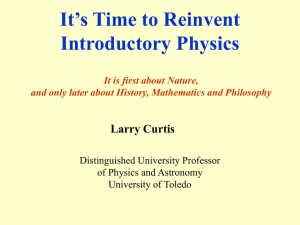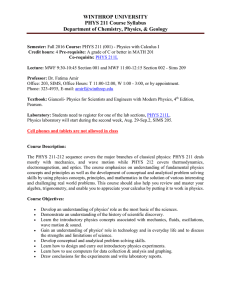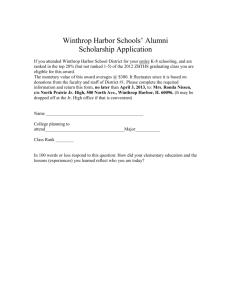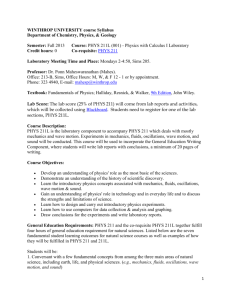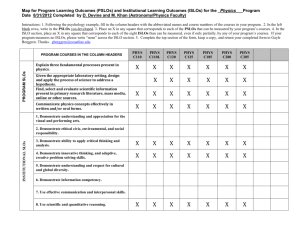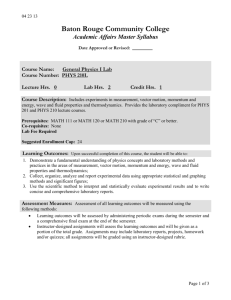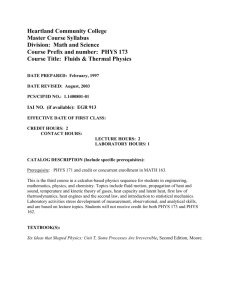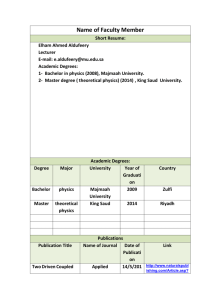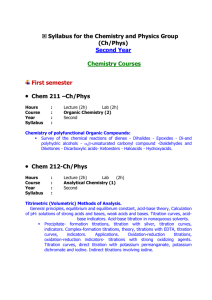PHYS 202L 001 Syllabus S2015
advertisement
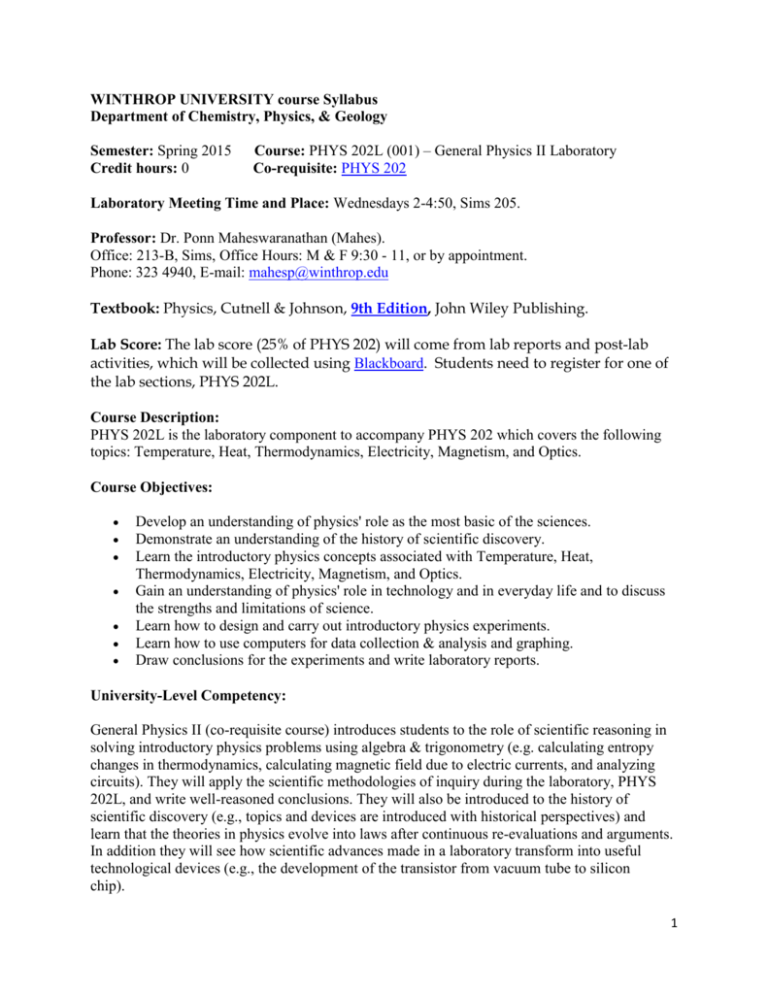
WINTHROP UNIVERSITY course Syllabus Department of Chemistry, Physics, & Geology Semester: Spring 2015 Credit hours: 0 Course: PHYS 202L (001) – General Physics II Laboratory Co-requisite: PHYS 202 Laboratory Meeting Time and Place: Wednesdays 2-4:50, Sims 205. Professor: Dr. Ponn Maheswaranathan (Mahes). Office: 213-B, Sims, Office Hours: M & F 9:30 - 11, or by appointment. Phone: 323 4940, E-mail: mahesp@winthrop.edu Textbook: Physics, Cutnell & Johnson, 9th Edition, John Wiley Publishing. Lab Score: The lab score (25% of PHYS 202) will come from lab reports and post-lab activities, which will be collected using Blackboard. Students need to register for one of the lab sections, PHYS 202L. Course Description: PHYS 202L is the laboratory component to accompany PHYS 202 which covers the following topics: Temperature, Heat, Thermodynamics, Electricity, Magnetism, and Optics. Course Objectives: Develop an understanding of physics' role as the most basic of the sciences. Demonstrate an understanding of the history of scientific discovery. Learn the introductory physics concepts associated with Temperature, Heat, Thermodynamics, Electricity, Magnetism, and Optics. Gain an understanding of physics' role in technology and in everyday life and to discuss the strengths and limitations of science. Learn how to design and carry out introductory physics experiments. Learn how to use computers for data collection & analysis and graphing. Draw conclusions for the experiments and write laboratory reports. University-Level Competency: General Physics II (co-requisite course) introduces students to the role of scientific reasoning in solving introductory physics problems using algebra & trigonometry (e.g. calculating entropy changes in thermodynamics, calculating magnetic field due to electric currents, and analyzing circuits). They will apply the scientific methodologies of inquiry during the laboratory, PHYS 202L, and write well-reasoned conclusions. They will also be introduced to the history of scientific discovery (e.g., topics and devices are introduced with historical perspectives) and learn that the theories in physics evolve into laws after continuous re-evaluations and arguments. In addition they will see how scientific advances made in a laboratory transform into useful technological devices (e.g., the development of the transistor from vacuum tube to silicon chip). 1 Attendance and Participation: The attendance policy described in the Winthrop University undergraduate catalog will be followed. Students are encouraged to attend all the labs and to actively take part in laboratory activities. Students with Disabilities: Winthrop University is dedicated to providing access to education. If you have a disability and require specific accommodations to complete this course, contact the Office of Disability Services (ODS) at 803-323-3290. Once you have your official notice of accommodations from the Office of Disability Services, please inform me as early as possible in the semester. Student Conduct Code: The policy on student academic misconduct is outlined in the “Student Conduct Code Academic Misconduct Policy” in the online Student Handbook (http://www2.winthrop.edu/studentaffairs/handbook/StudentHandbook.pdf). Syllabus change policy: The instructor will make changes to this syllabus as deemed necessary for the progression of the course. Rules for the laboratory: 1. You must read the web-link and the relevant materials from the textbook before the lab period and be prepared for the laboratory. 2. You will work in a group of two. Both partners should actively take part in collecting the data and in the experimental process. 3. At the end of your lab work you need to return all the laboratory equipment to the appropriate places where you took them. 4. You need to handle the equipment carefully, giving special attention when warranted. 5. When you leave the laboratory, you need to make sure the laboratory table is clean and free of any materials. 6. Do not miss any laboratory. You will receive "0" for all missed laboratories. 7. Lab reports are due at the end of the lab period, unless advised otherwise by the instructor. Lab Reports: At the completion of each lab every student is required to turn in a lab write-up. Students may work with their partner(s) to complete most of the write-up. This means sharing ideas not paragraphs. However, the conclusion section must be completed independently! Students are encouraged to be creative with their conclusions and explain whether or not their results are accurate. If the results are not close to the accepted values student are expected to give reasons for any discrepancies. The conclusion section is the part of the lab which is most important to check for student comprehension of the topic. 2 Lab # Week Experiment 1 Jan. 21 - 22 Heat 2 Jan. 28 - 29 Gas Laws 3 Feb. 4 - 5 Joule's Law and Heat Transfer 4 Feb. 11-12 Charge and Field: Instructions 5 Feb. 18-19 Resistance 6 Feb. 25-26 Ohm's Law 7 Mar. 4-5 Capacitor 8 Mar. 11-12 Meters 9 Mar. 25-26 Induction and Permeability Constant 10 Apr. 1 -2 Oscilloscope 11 Apr. 8-9 Spherical Mirrors and Lenses 12 Apr. 15-16 Interference and Diffraction Instructions Data 13 Apr. 22-23 Spectra 3 Even though you do the lab and collect data as a group, you should write your own conclusion. How to write a conclusion? * Conclusion is the most important part of your report. It is a brief summary-paragraph, about half a page. You must write your own conclusion, after completing the data collection and analysis. It must be written as the last piece and attached as the last piece, after data tables and graphs. * Conclusion should state things that are unique for your investigation which can be accomplished by including values of the experimentally determined physical quantities. Just remember that you cannot write your conclusion without completing your experiments or investigations. General statements like "I have determined the densities of given solids" and "Human Error" are not acceptable. Conclusion Points are listed for 10 point total lab report score: * Start your conclusion by re-stating the purpose with appropriate changes (0.2 pt). Then you need to briefly state (don’t repeat procedure) how you conducted the experiment and collected the data (0.2 pt). Continue this with summarizing your results (make it unique by listing your experimental values) (0.2 pt), referring to the data tables and graphs when appropriate, and answer the purpose (0.2 pt). Then you need to discuss about some of the difficulties you had, errors and their possible causes, and suggestions for improvement (0.2 pt). Describe your reasoning using physics terminology and principles. You should explain as completely as possible what goes through your mind that leads you to your conclusion. While we encourage you to discuss the investigations with your partners, your conclusion must be your own thought. 4
